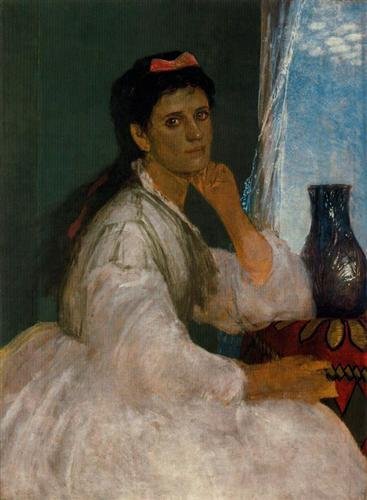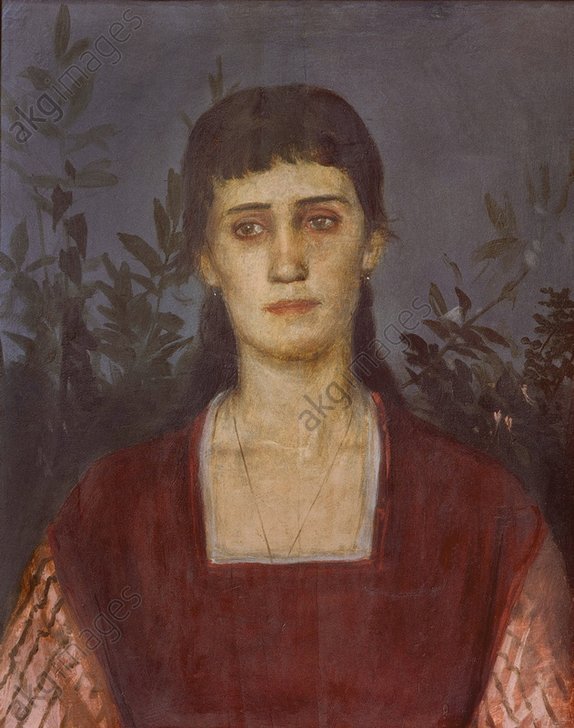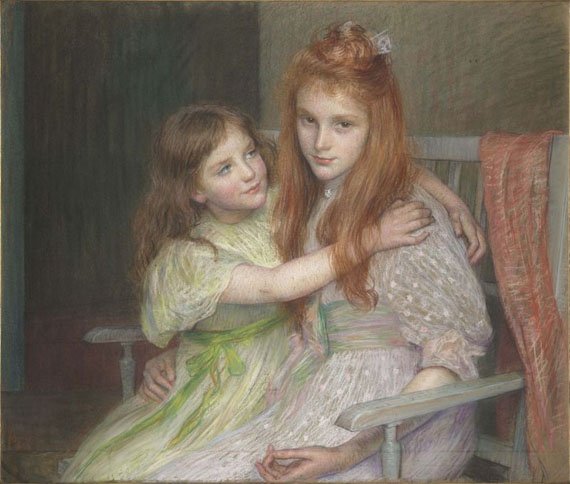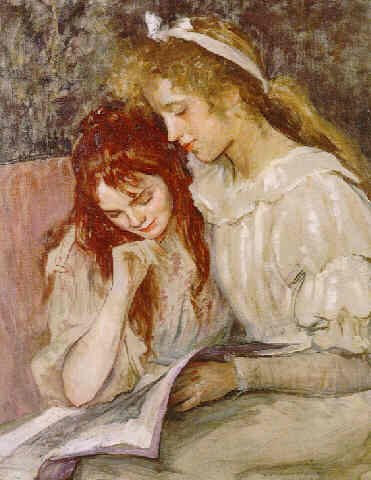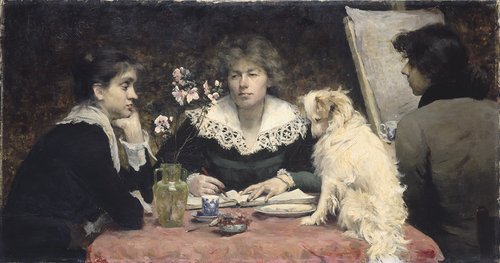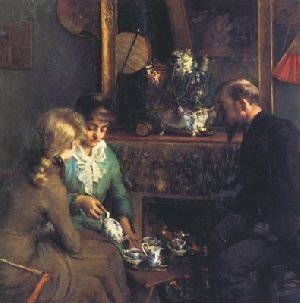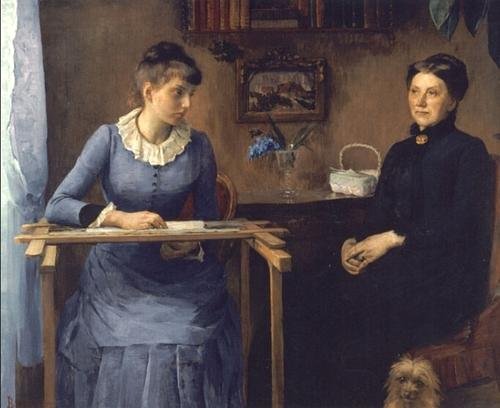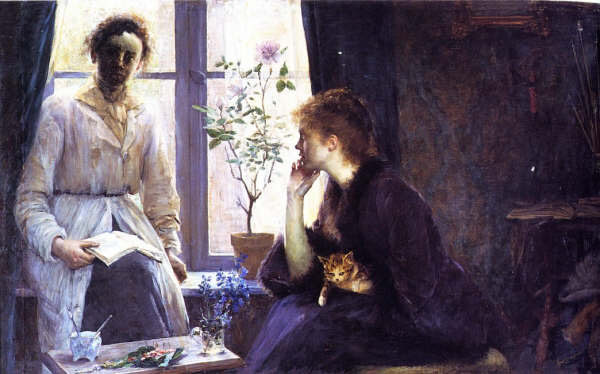
During the 1890’s Vallotton, besides painting and writing art criticism, spent much of his time working with woodcuts. The woodcuts he produced were looked upon as being very innovative and established him as a leading exponent of this type of art. Japonism was sweeping through the French art world during the last part of the nineteenth century and Vallotton’s work was influenced by the Japanese woodcut In 1890 there had been a large exhibition of ukiyo-e prints at the École des Beaux-Arts and like many people in France, Vallotton built up a collection of these prints.

Vallotton’s subjects ranged from domestic scenes to street crowd demonstrations in which police are depicted clashing with anarchists and from portrait heads to bathing women. In his 1896 woodcut entitled La Paresse (Laziness) he depicts a naked women relaxing face down on a bed whilst stroking a cat.

The high point of his woodcuts was probably reached in 1898 when he produced a series of ten interiors entitled Intimités (Intimacies), for the La Revue blanche, the avant-garde French art and literary magazine, which was published between 1889 and 1903 and had many influential contributors such as Toulouse Lautrec. The set of woodcuts dealt with the tensions between men and women and they proved so successful that they were circulated in magazines and books in Europe and America.
This set of woodcuts was a great success and for many critics there was a greater appreciation of them in comparison to his paintings. The ten woodcuts were dark with some white lines cut through the black background. Vallotton, through his woodcuts, wanted to bring out the continuing tensions between man and woman and that was further enhanced by the evocative titles he gave the individual works, such as Le Mensonge (The Lie), L’Argent (The Money) and L’ Irreparable (The Irreparable). In a way it was his way of denigrating love between man and woman, blaming the woman for being insincere and scheming creatures who often brought an element of spitefulness and dominance into a relationship.

Around 1892 Vallotton became associated with the Nabis art movement. The group came about around 1888 and was composed of disaffected artists who had passed through the Académie Julian and been subjected to the rigid representational methods being taught at that establishment. Founder members of the Nabis, which was a Hebrew word meaning prophet, were Pierre Bonnard, Édouard Vuillard and Maurice Denis. The Nabis were inspired by the broad planes of unmediated colour, using thick and bold outlines that were seen in Japanese prints.

Two examples of Vallotton’s take on the Nabi style art were his 1893 work entitled Das Bad. Sommerabend (Bathers on a Summer Evening), and his 1895 symbolist work Moonlight which can be found at the Musée d’Orsay
Bathers on a Summer Evening depicts women bathing in an open-air brick pool. The painting was exhibited at the 1893 Salon des Indépendents exhibition and its subject caused a furore but at the same time it successfully enhanced Vallotton’s reputation as an artist. In some way this painting is looked upon as a caricature of the traditional paintings of Salon artists such as Seurat and Renoir . The painting is housed in the Kunsthaus, Zurich.

In 1899 Félix Vallotton married Gabrielle Rodrigues-Henriques née Bernheim. Gabrielle was the daughter of Alexandre and Henriette Bernheim and was one of six children. Alexandre Bernheim came from Besancon and was an art dealer and friend of a fellow countryman of Besancon, Gustave Courbet. Gabrielle was eighteen months older than Félix Vallatton and had married Gustave Rodrigues Henriques in February 1883 and the couple had three children, Max, Joseph and Madeleine. Gustave died in 1894 at the young age of 34 leaving his widow financially comfortable. Gabrielle and Félix married five years later in 1899. Félix wrote to his brother Paul and told of his relationship with Gabrielle. He wrote:
“…I love her very much which is the main reason for this marriage, and she loves me also, we know each other very profoundly, and we trust each other. In short, I regret nothing and I nourish the highest hopes…”
In 1899, the year of his marriage to Gabrielle he painted a picture of her sitting at a table.
As I mentioned in my last blog about Vallatton, what drew me to him was the headline of a 2007 essay in The Guardian newspaper by the writer Julian Barnes:
The neglected, enigmatic Swiss artist Félix Vallotton was a fine painter of still lifes, landscapes and portraits. Shame about his dreadful nudes, writes Julian Barnes
I was intrigued to find out what was “dreadful” about Vallatton’s portrayal of nudes.

In 1905 Vallatton’s neo-classical style painting Models Relaxing was exhibited at the Ingres retrospective at the Salon d’Automne in Paris.

One of Ingres’ works Turkish Bath was also on view at the exhibition. It is said that Vallatton was moved to tears by this Ingres’ work and maybe that was the reason that two years later, in 1907, Vallatton completed his own painting entitled Turkish Bath.

The women in his painting were not hand maidens of a harem but were women of the 1900’s with their fashionable hairstyles.

Controversy was not far away when his nude paintings were exhibited, At the beginning of the twentieth century one exhibition of his work only allowed over 18 years of age visitors to enter and witness the naked women ! Depicting his nudes as part of mythology did not decrease the censure of the critics. An example of this is his 1908 painting entitled The Taking of Europe which is housed in the Kunstmuseum Bern.

Another of Vallatton’s paintings featuring a nude but with mythological connotations was his version of the story of Perseus slaying the dragon, a story which had featured in many pasintings before. Vallatton completed his up-to-date version of Perseus Slaying the Dragon in 1910 and it is now owned by the Musée d’Art et d’Histoire de Genève .

Vallatton painted hundreds of pictures featuring nude or semi-nude females and the one I like the most is his 1908 work entitled Woman with a Black Hat. The woman’s face is flushed as if she is embarrassed to appear semi naked before the artist. It adds to he vulnerability and in a way enhances her beauty.

Vallatton kept a register of all the works he completed and by the time of his death the list catalogued almost 1600 works. I have looked at his portraits and his penchant for painting nude females but of all his works, for me, his landscapes stand out. It was in his latter years that Vallatton produced most of his landscape works, such as Landscape Semur which he completed in 1923.

Another interesting painting was completed a year later in 1924 and entitled The Chateau-Gaillard in Andelys. Since 1909, Vallatton had a summer home in Honfleur and in 1924 whilst en route to his summer residence he passed through the small village of Andelys which lay on the banks of the Seine. He had first visited the village eight years earlier. The village is dominated by the ruins of Chateau Gauillard, a fortress built by Richard the Lionheart in 1196. It is situated on a hill overlooking Andelys. The ruins fascinated Vallatton who produced a number of paintings and sketches featuring the once mighty fortress. The painting is housed in the Musée A.G. Poulain de Vernon in Vernon, a town about 30 kilometres south of Andelys.

Another art genre that interested Vallatton in the early twentieth century was Still Life painting. In 1925 he completed a work entitled Nature morte a la peinture chinoise (Still Life with Chinese painting). Like many still life paintings the artist has challenged himself by having to paint a white napkin, with all its creases and folds, looking as if it is laying over the edge of the table. The Chinese painting mentioned in the title can be seen in the background.

One of my favourite still life paintings by Vallotton was a work entitled Parrot Tulips. I love the richness of the colours used and love to study the way Vallotton has depicted the individual items which crowd the scene.
Vallotton’s life came to a close at the end of 1925. His brother Paul’s daughter Marianne recalled the time:
“...It was the end of of the year 1925 and the weather was grey and gloomy, but in accordance with our old custom, we were getting ready to celebrate Christmas, when on 21 December my father received a letter , whose opening lines I quote:
‘ …My dear Paul, after examining me twice, they have decided to operate. It has been arranged for next Saturday morning the 26th. It would be nice if you could be here, for various reasons…’ “
Félix Vallotton died three days after his operation on December 29th, three days before his sixtieth birthday. According to Marianne Vallotton his last words to her father, his brother Paul were:
“…Don’t you think this is an amusing way to celebrate the centenary of the death of Jacques-Louis David?…”
The French painter died on December 29th 1825.
There were just so many apintings to include but so little time or space to accommodate them. To see more I can recommend the excellent book on the life of Félix Vallotton by Nathalia Brodskaïa entitled Félix Valloton, The Nabi from Switzerland. It was from this biography that I have been able to put together these two blogs on this talented Swiss painter.
Earlier I had mentioned the headline of an essay in The Guardian newspaper written by Julian Barnes. It is said that in a few years time he will be curating an exhibition of Félix Vallotton’s work at the Royal Academy in London and it will certainly be an exhibition not to be missed.




